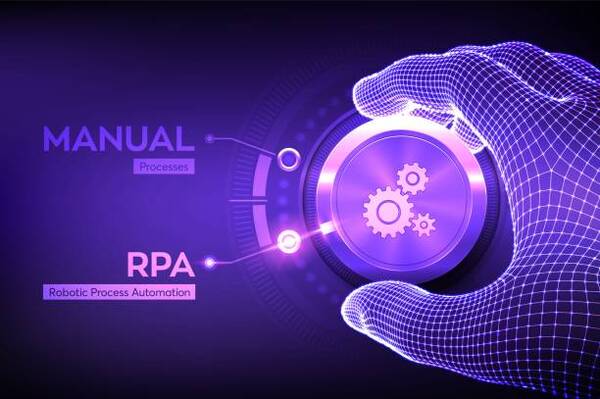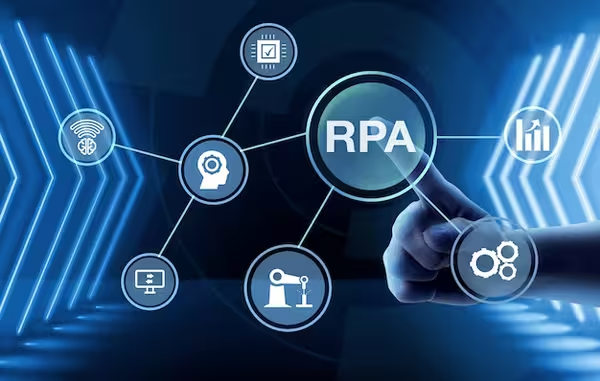
Revolutionizing Construction Cost Estimation with Robotics Process Automation (RPA)
The construction industry has always been at the forefront of innovation and adaptation to new technologies. From the development of modern construction machinery to the integration of advanced project management software, the industry has continually embraced tools that enhance efficiency and precision. In recent years, a remarkable technological advancement has taken center stage, reshaping the landscape of construction in ways previously unimaginable. This revolutionary force is known as Robotics Process Automation (RPA).
While RPA is often associated with streamlining business processes across various industries, its application in the domain of construction cost estimation is proving to be nothing short of transformative. RPA brings with it the promise of unparalleled accuracy, exceptional efficiency, and substantial cost savings, attributes that have long been sought after in the construction world. In this comprehensive article, we will embark on a journey into the world of RPA and explore the profound impact it is having on construction cost estimation, a cornerstone of the industry's success and sustainability.
Understanding Robotics Process Automation (RPA)
To truly appreciate the profound significance of RPA in the realm of construction cost estimation, we must begin by developing a comprehensive understanding of what RPA entails. RPA, which stands for Robotics Process Automation, represents a groundbreaking technological innovation that harnesses the power of software robots, colloquially referred to as "bots." These bots are not the robots we typically envision in science fiction, but rather highly sophisticated lines of code meticulously designed to automate rule-based, repetitive tasks.
What sets RPA apart is its remarkable ability to replicate human actions with an extraordinary degree of precision and speed. These software robots can perform an array of functions, ranging from mundane data entry and extraction to the execution of complex processes. RPA excels particularly in tasks that involve structured data and well-defined workflows, making it an innovation of immense consequence, especially in industries as multifaceted as construction.

The Crucial Role of Cost Estimation in Construction
Before we embark on exploring the myriad applications of RPA in construction, it is imperative to emphasize the paramount significance of cost estimation in this dynamic industry. Accurate cost estimation stands as an unshakable cornerstone of every construction project, influencing its trajectory from inception to completion. It serves as the bedrock of project planning, acting as the North Star guiding budgeting decisions and strategic choices.
Precise cost estimation is the compass that enables stakeholders to navigate the complexities of construction endeavors. It empowers them to assess the feasibility of projects, secure the requisite funding, and ensure the optimal allocation of resources. In stark contrast, inaccurate estimates can cast a long shadow over a project's progress. They have the potential to trigger budget overruns, set off cascading project delays, and in the most unfortunate scenarios, culminate in project failure.
Given these stakes, it becomes abundantly clear that enhancing the accuracy and efficiency of cost estimation is not merely a priority; it is an imperative in the realm of construction. This imperative has spurred the industry to seek innovative solutions, and at the forefront of this technological revolution stands RPA, poised to redefine the very essence of construction cost estimation.

Challenges in Traditional Construction Cost Estimation
Traditional methods of construction cost estimation are beset with challenges. These methods typically involve manual data entry, complex calculations, and a mountain of paperwork. Here are some of the common challenges associated with traditional cost estimation:
Human Error
Manual data entry is inherently susceptible to errors, which can lead to inaccurate cost estimates and potentially costly consequences.
Time-Consuming Processes
Traditional methods can be exceedingly time-consuming, leading to delays in project planning and execution.
Complexity of Calculations
Construction cost estimation involves intricate calculations and numerous variables, making it susceptible to errors and omissions.
Limited Access to Historical Data
Estimators may have restricted access to historical data, which can make it challenging to make accurate projections for future projects.
RPA in Construction Cost Estimation: A Paradigm Shift
The integration of RPA in construction cost estimation addresses many of the challenges faced by traditional methods. Here's how RPA is transforming this critical aspect of construction:

Data Collection and Processing
RPA bots excel at collecting data from various sources such as architectural drawings, material catalogs, and historical project data. This data is then processed and organized with unprecedented speed and accuracy.
Reducing Human Error
By automating data entry and calculations, RPA significantly mitigates the risk of human error. This leads to more reliable cost estimates and a higher level of confidence in project budgets.
Speed and Efficiency
RPA bots work tirelessly, without the need for breaks or downtime. This agility translates to a substantial reduction in the time required for cost estimation. In a fast-paced industry like construction, this efficiency is invaluable.
Scalability
RPA systems are designed to handle large volumes of data, making them suitable for projects of all sizes. Whether it's a small-scale residential project or a sprawling commercial development, RPA can adapt to the diverse needs of the construction industry.
Integration with Existing Systems
RPA can seamlessly integrate with existing construction management software, enhancing their capabilities and providing a holistic view of project costs. This integration streamlines processes and creates a more cohesive workflow.
RPA Success Stories in Construction Cost Estimation
To gain a deeper understanding of the impact of RPA on construction cost estimation, let's explore some real-world examples:
Automated Quantity Takeoff
RPA bots can extract quantities from architectural drawings and specifications, streamlining the quantity takeoff process. This automation ensures accuracy and saves a significant amount of time, allowing estimators to focus on more complex aspects of cost estimation.
Historical Data Analysis
RPA can analyze historical project data to identify cost patterns and trends. This analysis aids in creating more accurate estimates for similar future projects, leveraging the power of data to enhance precision.
Supplier Price Comparison
Bots can perform real-time comparisons of prices from various suppliers, helping project managers make informed decisions about material procurement. This ensures that projects are executed with cost-effectiveness in mind.
Budget Tracking
RPA can continuously monitor project expenses and provide real-time updates on budget adherence. This level of oversight allows for proactive cost management, enabling teams to address potential issues before they escalate.

Benefits of RPA in Construction Cost Estimation
The adoption of RPA in construction cost estimation yields a multitude of benefits:
Accuracy
RPA significantly reduces the potential for human error, leading to more precise cost estimates. This enhanced accuracy provides a solid foundation for project planning and execution.
Efficiency
Automation accelerates the estimation process, enabling faster project planning and decision-making. This increased efficiency translates to time and cost savings, ultimately benefiting the entire project lifecycle.
Cost Savings
Reduced labor costs, coupled with improved cost estimation, lead to significant savings over time. These savings can be reinvested into projects or used to bolster the bottom line.
Data Insights
RPA's data analysis capabilities provide valuable insights for project optimization. By leveraging data-driven decisions, stakeholders can make informed choices that positively impact project outcomes.
Scalability
RPA can seamlessly adapt to projects of all sizes, from small-scale renovations to large-scale infrastructure developments. This versatility ensures that the benefits of RPA are accessible to projects of varying scopes and complexities.
Overcoming Challenges and Implementation Considerations
While RPA offers substantial advantages, its implementation in construction cost estimation does come with some challenges and considerations:
Initial Investment
Implementing RPA requires an initial investment in software and training. However, the long-term benefits often far outweigh these costs, making it a wise investment for construction firms looking to enhance their competitiveness.
Change Management
Employees may need to adapt to new processes, which may require change management strategies. Proper training and communication are essential to ensure a smooth transition to RPA-driven cost estimation.
Data Security
Handling sensitive project data with RPA necessitates robust security measures to prevent data breaches. Construction firms must prioritize data security to maintain the trust of their clients and stakeholders.
Maintenance
Regular maintenance and updates are necessary to ensure the continued effectiveness of RPA systems. Proactive maintenance practices are crucial for maximizing the benefits of RPA over the long term.

The Future of RPA in Construction
As technology continues to advance, the role of RPA in construction cost estimation is likely to expand. Some future developments may include:
AI Integration
The integration of RPA with artificial intelligence (AI) will enable more advanced data analysis and predictive cost estimation. This combination of technologies has the potential to revolutionize how projects are planned and budgeted.
Enhanced Visualization
RPA systems may incorporate 3D modeling and visualization tools to provide a more comprehensive view of project costs. This enhanced visualization capability will offer stakeholders a more intuitive understanding of project budgets.
Remote Collaboration
RPA can facilitate remote collaboration among project stakeholders, enhancing efficiency and reducing the need for physical presence on-site. This will be especially relevant in a world increasingly shaped by remote work and digital collaboration.
Conclusion
Robotics Process Automation (RPA) is not just a technological leap; it is a strategic move toward a more efficient and competitive construction industry. By automating data collection, processing, and analysis, RPA significantly improves the accuracy and efficiency of construction cost estimation processes. This, in turn, leads to better project planning, budget management, and cost savings.
While there are challenges to overcome during implementation, the long-term benefits of RPA in construction are undeniable. As technology continues to evolve, we can expect RPA to play an even more significant role in reshaping the future of construction cost estimation, ultimately contributing to more successful and cost-effective construction projects.
Embracing RPA is not an option; it's a necessity for construction companies that seek to thrive in an increasingly competitive and dynamic industry. The construction industry's future is being built on the foundation of RPA, and those who embrace it will undoubtedly lead the way to a more efficient and prosperous future.
Check https://app.bidlight.com for how BidLight can help you estimate your BIM model!